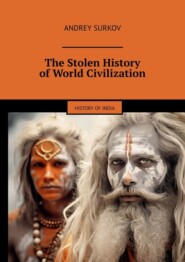
Полная версия:
The Stolen History of World Civilization. History of India

The Stolen History of World Civilization
History of India
Andrey Surkov
© Andrey Surkov, 2023
ISBN 978-5-0062-0882-7
Created with Ridero smart publishing system
All artistic illustrations were made by the author using the midjourney.com neural network with documented historical accuracy.
Chapter 1. Ancient India and its neighbors
At first glance, it may seem that the history of India has been irretrievably lost: something deliberately destroyed by previous rulers’ generations, something rewritten by colonisers, and almost nothing has survived in its original form. However, history can be reconstructed, if not in its details, then in its core. India has always been surrounded by a whole world that could not help but interact with such a rich and developed region. In addition, the fact that India was very rich and developed is told to us by literally everything, and first of all by the richest architecture and archaeological research.
Let us take a look at the regions that bordered India and explore how they interacted with it. We can immediately recognize the Persian Empire as one such region, a rich and advanced part of the ancient world, on par with India.

Arias. Artistic reconstruction of the author.

Aryas of the first ancient states on the territory of India. Artistic reconstruction by the author.

Aryas of the first ancient states on the territory of India. Artistic reconstruction by the author.
The Aryas played a significant role in the establishment of the Persian Empire, much like the great states of India. The Persian Empire rulers’ direct testimonies and records have been preserved in stone. It is unfathomable that two of the wealthiest regions in the ancient world, with overlapping cultural, linguistic, and religious origins, failed to pursue active interactions, engage in vigorous and large-scale trade, and mutually enrich each other’s cultures. The contemporary historical tradition, which was penned according to 19th century colonial powers orders, asserts that the Persian Empire focused all their attention on the scarcely populated Southern Balkans and only had distinctive and exclusive relations with this world region. However, a closer examination with an unprejudiced approach makes it clear that this is a historical fabrication.

Ancient cities of India. Artistic reconstruction by the author.
By the end of the eighteenth century, Britain initiated the acquisition of India and, subsequently, in the early nineteenth century, the British Empire gained control over a portion of the former Ottoman Empire that was located in the Southern Balkans. During the second half of the 18th century, the British political elite issued a directive to produce its own world history, which was in opposition to the extensive historical rewriting taking place in all regions of the world. This task was carried out by talented English writers, who, unfortunately, were not scientists, and, consequently, the work contained so many inconsistencies and outright falsifications. Currently, many people recognize this historical forgery. However, in the last century, everyone accepted this fabricated history without any critical analysis.

Ancient cities of India. Artistic reconstruction by the author.
The world civilization creation history, which began in India and reached its development peak there, was artificially transferred to the small area of the Southern Balkans solely because of its location in Europe and its full control by Britain. What purpose does such a grand deception serve? Firstly, to deprive humanity of knowledge regarding the modern world civilization origins and development. To separate the parts that have been torn away from each other – India and Russia – as far as possible from one another and to prevent their reunification in the future. To declare Western Europe as the center of civilization and to appropriate the entire world civilization for oneself.

Aryas. Artistic reconstruction by the author.
To declare the rest of the world as some other «alternative civilizations» which proved to be unsuccessful in a competitive confrontation with the European civilization, and, therefore, by our time they have all disappeared as political and state subjects. To create the illusion that the entire modern world has accepted the European civilization and lives by its standards, and, therefore, this civilization’s representatives have the moral right to impose their will on the rest of the world, and to teach us the civilized, Western European, way of living. In the modern world, these are such obvious axioms that in the political aspect no one, except for Russia, tries to challenge them or object to them.

Ancient cities of India. Artistic reconstruction by the author.
Studying the history of India destroys this seemingly unshakable construction of the English quirky mind. It becomes apparent that this whole ideology is very weak. Just try to approach this story with an open mind.
During the ancient period, the two wealthiest and most developed regions with a shared border were India and the Persian Empire. Naturally, the main trade and foreign relations took place between these two regions.

The King of Kings of the Persian Empire. Artistic reconstruction by the author.
It is obvious that the economic, trading, and, consequently, the political interests between these two regions exceeded any other interest in any other peripheral region along their borders. Perhaps, with the exception of Scythia, which was the ancestral home for the military and creative elites of both these mega regions and served as the source of military strength for the Great Indian States and Persian Empire.
Regarding modern Europe’s territory, it was likely a remote and underdeveloped region of the Persian Empire, and this part hardly played any significant role at that time. Without its own history, Western Europe, in the Modern Era, after the 18th century’s devastating events, simply appropriated someone else’s history, including the very name «Europe,» which was originally known as «Hellas» in ancient times. However, it was modern India that was the very ancient Europe – Hellas.

Ancient cities of India. Artistic reconstruction by the author.

Scythian King. Artistic reconstruction by the author, based on information from the tomb of the Scythian kings in Ukok, Altai.
The connection between the Persian Empire and Hellas, which is the source for ancient authors’ writings, is, in fact, the relationship between India and Persia in ancient times. This book aims to demonstrate the unsuccessful attempt of Western European authors to rewrite history and the historical forgery they have perpetuated. My mission is to reconstruct the true history of India.

Scythian queen. Artistic reconstruction by the author, based on information from the tomb of the Scythian kings in Ukok, Altai.
Chapter 2. Aristotle – Chanakya and Alexander – Chandragupta. Teacher and Student

Chandra-Gupta (Alexander). Artistic reconstruction by the author.

Chanakya (Aristotle). Artistic reconstruction by the author.
At the beginning of the 20th century, the accumulated archaeological evidence made it impossible to remain silent about India’s history and the lack of given attention to its study.
During the 19th century, a number of researchers cautiously revealed some of the most significant events and personalities in Indian history. However, in that particular period, it was unfeasible to assert openly and explicitly that the complete ancient Hellenistic civilization was a part of the Indian history, due to political biases in colonial ties and prevailing erroneous ideologies.

The ancient city of Pataliputra. Artistic reconstruction by the author.
The discoveries made in the East during the 18th and 19th centuries served as shocking evidence of an ancient, remarkable civilization that was previously unknown to the Europeans. Their dogmas were crumbling before the ordinary masses and the educated elites, who had not the slightest idea of reality.
This finding shattered the previously held prejudice that savagery, barbarism and primitive conditions were prevalent outside of the Western Europe.

Ancient cities of India. Artistic reconstruction by the author.
Needless to say, it was unlikely for Western European scholars to acknowledge the modern civilization’s origin, especially in India, since this territory held a vital importance to the British Empire, given the vast resources it possessed for sustaining British global supremacy. It was highly taboo to view the history of global civilization beyond a limited, Europe-centric perspective. However, in Indian history, it was necessary to mention two significant personalities in the scholarly research process in order to avoid potential bias favoring the colonial nations ruling circles. As the English proverb goes, «If you can’t beat ’em, join «em». We are referring to the eminent scholar Aristotle and his equally eminent student Alexander the Great, – world empire creators that united the entire world into a single cultural and political whole.

Ruins of the ancient University in Taxila, documentary photography, freely available.
Aristotle’s «return» to his homeland, India, under the name of Chanakya, gives us an opportunity to trace the geography, without which, historical science cannot fully exist.
The university in which Aristotle – Chanakya taught and supervised was located at Taxila.
The scientific community has reached a general consensus that Aristotle and his student Alexander the Great have been known by the names they used in their lifetimes or, at the very least, in ancient times.
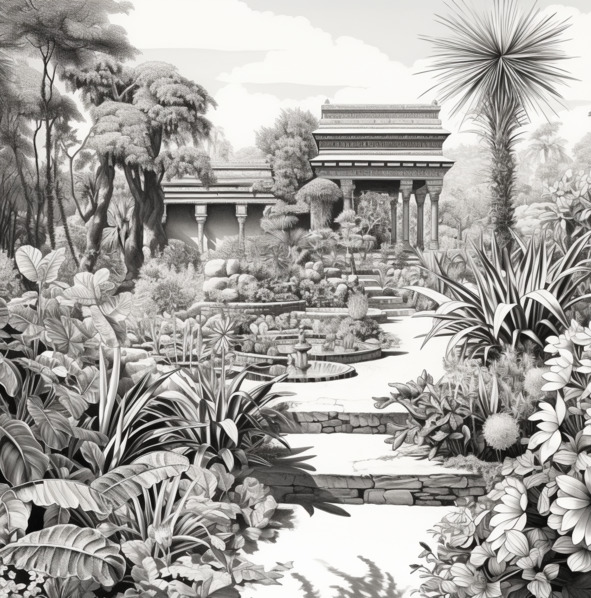
Ancient Academy. Artistic reconstruction by the author.
There are several archaeological discoveries, such as busts and sculptures depicting their likeness, as well as inscriptions with their names from the same era. It was necessary to invent alternative names for Indian history, which was being recreated in the early 20th century. For instance, Chanakya was used as a replacement for Aristotle. The name Chanakya refers to one of the main characters in the book «Mudrarakshasa,» which is a retelling of the Hellenistic myth of Damon and Pythias. This same myth was also used in Schiller’s ballad «Die Bürgschaft» in 1799. However, Bharatendu (Rasa), the esteemed founder of Hindi literature, published «Mudrarakshasa» much later, in 1875. Hence, it is evident that Chanakya was named after Aristotle.

Aryas. Artistic reconstruction by the author.
Aristotle’s primary work, namely «Politics,» is of immense value for comprehending the nature of his career as both a philosopher and political theorist. Similarly, in 1909, Chanakya’s primary political and economic work, the Arthashastra, was published. Numerous scholars have analyzed the dispute regarding which work takes precedence – Chanakya’s «Arthashastra» or Aristotle’s «Politics.» But it is essential to acknowledge that Aristotle and Chanakya are, in fact, one and the same individual. It is futile to argue which book is primary.»
Arthashastra, literally translated from Sanskrit, means «the science of ruling over the material world,» which can be perceived as an artistic depiction of the concept of «politics».
Having examined all relevant evidence pertaining to both Aristotle and Chanakya and concluding that they are the same person, it is clear that ancient India, the center region of what was known as Europe in the ancient times, served as a nexus point for the lives and achievements of numerous heroes, scholars, and other figures from antiquity. This conclusion is based purely on objective analysis without any personal bias.

Aryas. Artistic reconstruction by the author.

Aryas. Artistic reconstruction by the author.

Aryas. Artistic reconstruction by the author.
Chanakya and Aristotle: a Comparative Biography

Ancient Academy. Artistic reconstruction by the author.

Chanakya 370—283 B.C. Artistic reconstruction by the author based on archival materials from India.
Chanakya, a renowned scholar and teacher, wrote notable political and economic works. Chanakya studied at the renowned university of Taxila: the most famous learning centre of his time. Despite the fact that Chanakya’s parents are never spoken about beyond this period, it can be speculated that they had passed away prior to his enrollment at the University, as he never met or spoke of them again. Upon completing his studies at the University, Chanakya accepted the position of teacher (acharya) at the same institution. There are no details regarding Chanakya’s birthplace or his parents’ place of residence. Chanakya’s life revolves around two focal points: the Taxila University and the capital city of Pataliputra.
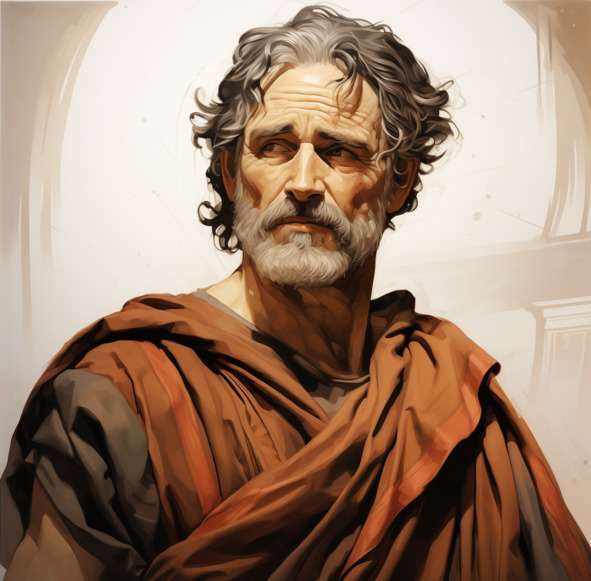
Aristotle 384—322 B.C. Artistic reconstruction by the author in the European historical tradition.
Aristotle was a renowned academic and educator, revered for his seminal contributions to the fields of politics and economics. He served as a mentor and teacher to Alexander the Great. After the premature death of his parents in childhood, Aristotle was raised under the care of a guardian. When Aristotle turned 17, he enrolled in Plato’s Academy, which was the most highly regarded educational institution of the era. After completing his studies at the Academy, Aristotle embarked on a career as a teacher and remained at the institution for two decades, until he reached the age of thirty-seven. Aristotle soon left the academy and began teaching Alexander the Great in 343 BC. Aristotle’s life is associated with two specific locations: The Academy of Plato and the city of Athens.

Chanakya, the teacher and inspirer of Chandragupta. Artistic reconstruction by the author.
Chanakya had a strong alliance with the mountain king Parvata, who staunchly supported his plans.
As per some versions of the hagiography, Chanakya’s disciple, Chandragupta, was said to be the son of the king, who was deprived of his right to the throne and was thus forced to seize power. Due to a preplanned scheme, King Nanda was killed, and Chandragupta was able to ascend to the throne.

Aristotle and King Hermias had a close alliance. The king was heavily influenced by the philosopher’s teachings and frequently attended his lectures. Aristotle married the king’s adopted daughter, Pythias.
In 337 BC, Philip the Second divorced Olympias, Alexander’s mother, and married Cleopatra. As a result, Olympias left the royal court and the capital with her 18-year-old son. Philip anticipated that the young Queen Cleopatra would bear him a son, thus causing Alexander to lose his claim to the throne.
After the conspiracy, King Philip was assassinated and Alexander assumed the role of king.

Chanakya was a part of King Dhan Nanda’s inner circle. However, the king insulted and humiliated Chanakya, which prompted him to vow for revenge.
Upon meeting Chandragupta, who was still a young child, Chanakya began training him with the aim of elevating him to the royal throne.
Chanakya meticulously searched for a worthy candidate to carry out his plan, and he found young Chandragupta, who, even as a child, possessed the qualities of a natural leader and commanded respect from his peers.

Aristotle’s father served as a court physician and was acquainted with Amyntas III, the grandfather of Alexander the Great. This allowed Aristotle to become a member of the royal court circle and study at the Plato’s Academy without impediment.
Yet, his hometown, Stagira, fell to the Macedonian King Philip II, leading to its destruction.
Aristotle commenced tutoring Alexander in his early teenage years. In his youth, Alexander demonstrated exceptional leadership abilities amongst his peers, prompting Aristotle to believe his future success as a great ruler.
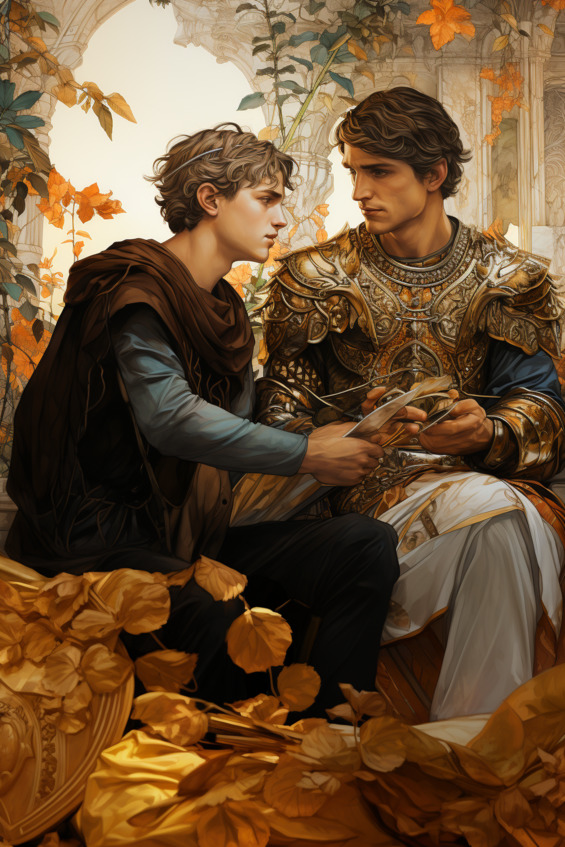
Young Alexander and Aristotle. Artistic reconstruction by the author.

Young Chandragupta and Chanakya. Artistic reconstruction by the Author.
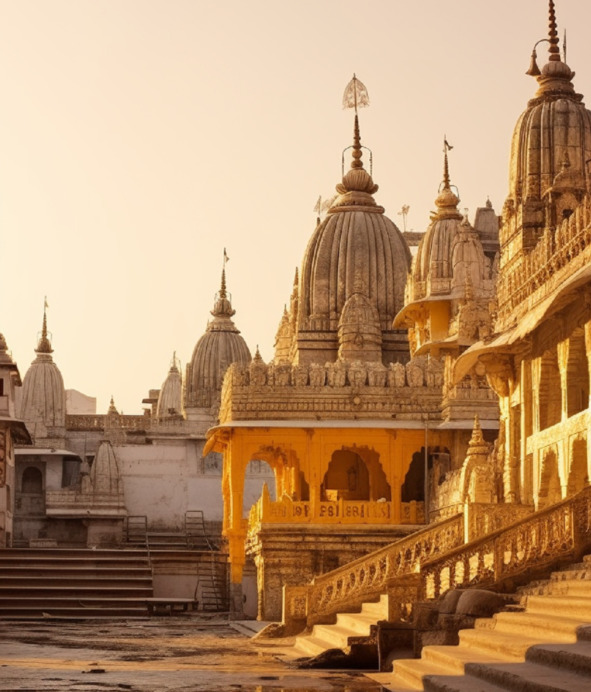
Ancient cities of India. Artistic reconstruction by the author.
Chanakya’s literary works such as the Vishakhadatta drama, Mudrarakshasa, Ceylon chronicles, Puranic collections, and the contributions of Acharya Hemachandra were rewritten in the early twentieth century. For instance, the Arthashastra was published in 1909. These works were previously considered to be lost, however, at the beginning of the 20th century, they were «found» as new works rewritten from their original sources were discovered. The original sources, unfortunately, were not preserved.

Ancient cities of India. Artistic reconstruction by the author.
Manucius first published Aristotle’s works in Venice at the beginning of the 16th century.
Later, Erasmus of Rotterdam revised and corrected those texts, after which the revised edition was published in Basel in 1531.
Silburg in Frankfurt made another adjustment in 1584.
Boulez proceeded with a new edition in Greek and Latin, consisting of five volumes, in Zweibrücken and Strasbourg, and which was released between 1791 and 1800.
During the 19th century, the Berlin Academy led the effort of creating a comprehensive edition consisting of five volumes of Aristotle’s works, including commentaries, scholia, and fragments (Berlin, 1831—71).
This edition also served as a handbook for the French edition of Dido in Paris (5 vols. 1848—1874).
Unfortunately, the original ancient manuscripts that were transported from Constantinople to Venice in the mid-15th century, and served as the basis for new publications, either did not survive or were destroyed.

Aristotle is in exile. Artistic reconstruction by the author.
Following the death of Alexander the Great, Aristotle was accused of impiety, and subsequently exiled from Athens.
After relocating to Chalcida of Euboea, Aristotle eventually passed away a year later after ingesting poison.
Although some speculate that his death was intentional, alternative sources suggest that Aristotle’s demise resulted from a stomach ailment, which affected his ability to eat.
It is possible that this illness resulted from poisoning

Chanakya. Artistic reconstruction by the author.
Following the death of Chandragupta, Chanakya was subjected to slander and subsequently exiled. Later, he died as a result of a severe starvation, which is widely believed to have been a suicide. Another account attributes Chanakya’s death to the poisoning by one of the ministers at court.

Aristotle. Artistic reconstruction by the author.
It is widely acknowledged that Aristotle influenced the pragmatic approach of Alexander the Great towards the Empire’s administration and organizational affairs, including those of a spiritual nature. He prioritized the practical interests of both the state and its stakeholders over established customs and laws. Additionally, Aristotle provided Alexander with moral and ethical guidance on ruling. He advised his student that a genuine leader should display empathy towards the vulnerable and defenseless, without feeling ashamed of compassion and refraining from cruelty. Furthermore, he counseled young Alexander to live a moral life, embodying the principles of morality through his actions while avoiding anger. He imparts to Alexander the true essence of power, not just its external facade.

Chanakya. Artistic reconstruction by the author.
Chanakya prioritized practical interests above all else. He believed that if the law was incompatible with the public interest, the latter should be given precedence. Furthermore, if he deemed the law to be in conflict with the public interest, then he advocated for the latter.



